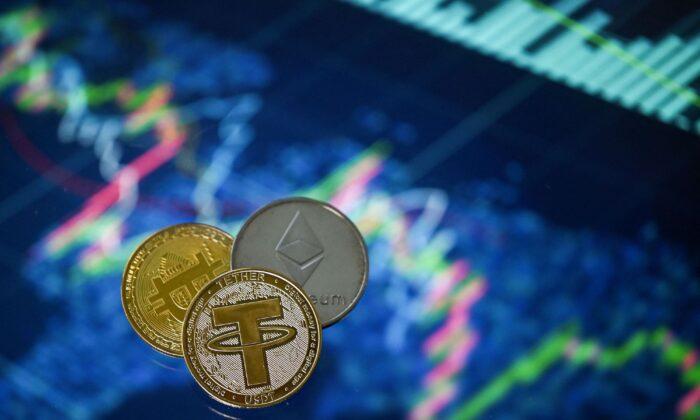‘We’re trying to make money as easy to move as sending an email,’ said Cory Then, Circle vice president.
The courtroom drama of FTX founder Sam Bankman-Fried’s trial for securities fraud is, in many ways, a sideshow to the more significant developments that are taking place in the crypto market behind the headlines.
Cryptocurrencies are continuing their expansion and evolution, often outside the control of governments and banks, while regulators around the world are struggling to find ways to tame this “wild west” technology and bring it under control. In the wake of the FTX collapse and other financial scandals, tighter regulation of crypto seems inevitable, though what form that will take is currently up in the air.
“We’re already seeing more regulation of cryptocurrencies, both at the state and the federal level and internationally,” Daniel Silva, a former federal prosecutor who’s currently a shareholder at business law firm Buchalter, told The Epoch Times. “There’s lawsuits by the SEC against Coinbase; Binance is facing lawsuits by both the SEC and the CFTC; there’s bankruptcies all over the place in the crypto industry; and there’s lawsuits within those bankruptcies.”
Market watchers say that much of the regulatory action has been selective and after the fact, rather than part of a coherent regulatory framework. And arbitrary regulation may constrain America’s ability to develop financial innovations and keep pace with the rest of the world.
“What you have is an environment where we cannot get the regulators to come forward with any sort of clear set of requirements,” Sen. Bill Hagerty (R-Tenn.), a member of the Senate Banking Committee, told an audience gathered at the Cato Institute on Sept. 7. “You’ve got companies that are basically being regulated in arrears.”
“They proceed according to what they think is legitimate business practice, and the SEC deems that illegal and comes back and charges them for something that was never on the books as being legal or illegal,” he said. “It is a terrible environment for those companies that are trying to invest and expand, and it’s forcing them to look overseas to more favorable regulatory environments.”
Mr. Hagerty is one of a number of legislators in both the Senate and the House who have introduced bills to regulate the crypto industry, though some bills are more restrictive than others. While the United States grapples with how to keep the crypto market in check, other jurisdictions, like the UK, Japan, Singapore and the European Union, have moved ahead, setting up regulatory regimes that will foster the crypto industry, analysts say.
“The biggest problem with crypto regulation in the United States right now is the lack of clarity, which demonstrates itself in hostility to crypto innovation and crypto technology,” Jennifer Schulp, Cato’s director of financial studies, told The Epoch Times. “But the problem is compounded by the fact that a lot of international jurisdictions have been providing clarity in the digital asset space, and it hurts U.S. competitiveness.”
“The fact that the U.S. dollar is the reserve currency in the world is a huge competitive advantage for us,” Mr. Hagerty said. “Our policies to continue innovation in that arena are absolutely critical.”
A Vision for Money Not Controlled by Governments or Banks
The crypto market
emerged in 2009 with the development of bitcoin, based on a vision that blockchain technology could create decentralized money that is not controlled by governments or Wall Street banks. It has since grown to an estimated 100 million cryptocurrency “wallets,” which are digital accounts in which individual users hold these tokens.
But this technology, and its promise of financial freedom, has not sat well with government officials.
Securities and Exchange Commission (SEC) Chair Gary Gensler expressed his disdain for the crypto market, telling CNBC on June 6, “We don’t need more digital currency…we already have digital currency, it’s called the U.S. dollar.”
One of the issues with developing new crypto regulations is the fact that it places the government in the role of setting down rules for a technology that was created to escape from government, both in terms of the government’s ever-expanding financial surveillance and the loss of value of fiat currencies like the dollar through inflation.
“If we leave the development of the legal framework surrounding the payment system to the Federal Reserve and traditional legacy banks, they will create a framework that is best for them,” Julie Hill, a professor at the Alabama School of Law who focuses on financial regulation, told Cato attendees. “They will not create a framework that is best for everyone.”
Regulatory efforts have often been characterized by both a limited understanding and an antipathy towards the industry. Some in the finance world have even called for an outright ban of cryptocurrencies.
Berkshire Hathaway Vice Chairman Charlie Munger wrote in a Feb. Wall Street Journal op-ed that crypto was not a currency or a commodity or a security, but merely “a gambling contract with a nearly 100% edge for the house.” China has “wisely” taken the lead in banning crypto, he said.
Speaking at The Economic Club of New York in 2021, Fed Chairman Jerome Powell likewise derided cryptocurrencies as merely “vehicles for speculation.”
Many other critics have asked why, given that scandals like the FTX collapse in which approximately $9 billion of customer funds went missing, the U.S. should want to have a crypto industry at all.
Crypto Falls Short
Crypto skeptics point out that it has fallen far short of its promise. Even bitcoin, the original and most commonly traded token, has not come close to rivaling fiat currencies like the U.S. dollar in the basic functions of money: a store of value, a medium of exchange, and a unit of account. Cryptocurrencies have been far too volatile to be a store of value. Indeed, as FTX’s token, FTT, demonstrated, many crypto currencies have had no inherent value at all.
FTT’s value fell from a high of more than $70 per token in September 2021 to $25 per token by October 2022, then plummeted to effectively zero within days as FTX collapsed. Bitcoin, which at its peak in October 2021 reached a valuation of $61,000 tumbled in the spring of 2022 to $20,000 before recovering to its current valuation of around $27,000.
Beyond valuations, the crypto exchanges themselves, which provide the platforms to buy and sell the tokens, have also been scandal-prone, exposing customers to the risk of their money simply disappearing.
As Mr. Gensler stated in the CNBC interview, crypto exchanges have operated differently from America’s traditional stock and bond markets, for example co-mingling customers’ money in the way that FTX allowed Alameda Research, an affiliated hedge fund, to
use customer funds for trading losses, debt repayment and political contributions.
“We don’t see the New York Stock Exchange also operating a hedge fund,” Mr. Gensler said.
The SEC also
brought charges in February against Binance, the largest crypto exchange, as well as other exchanges, Genesis, Gemini, and Kraken, for offering unregistered tokens. This sparked a flood of customer withdrawals, with Binance’s token, Binance USD (BUSD) experiencing $6 billion in outflows.
Down But Not Out
As Mark Twain once said, upon reading his own prematurely published obituary, “the news of my death was greatly exaggerated.”
All of the setbacks over the past year may simply be the chaotic beginnings of a viable industry that is still finding its legs, market analysts say. They note that there is still a demand for assets that will hold their value in times of high inflation and for transactions that are not controlled by the government or Wall Street.
And one segment of the crypto market that is perhaps the fastest growing segment is stablecoins, which promise to make payments faster and easier.
Stablecoins are different from blockchain tokens like bitcoin in that they are collateralized by assets, typically some combination of U.S. dollars and Treasury bills. They could also be backed by other fiat currencies, or even commodities like gold.
In theory, the value of stablecoins would remain in parity with the dollar, or whichever other currency or commodity they are linked to. While this does not offer a store-of-value any greater than the dollar, it does allow for de-centralized ownership and faster, cheaper payments than the current bank-centered system.
One of the companies that has developed stablecoins is Circle, which hopes that its token will revolutionize global payment systems. Circle’s stablecoin, USD Coin (USDC), is the second largest stablecoin, with a current market cap of around $25 billion.
“We’re trying to make money as easy to move as sending an email,” Cory Then, vice president at Circle, told attendees at the Cato conference. “When you send an email today, you don’t worry about, if you have Gmail and your friend has Hotmail, whether it’s going to arrive, and you don’t worry about whether sending an email to Europe is going to take seven days and cost you money; you expect it will arrive instantaneously.”
Mr. Then says Circle has settled $11 trillion in payments since its inception five years ago, and more than $4 trillion in 2022 alone.
“We’re essentially changing the form factor of a dollar and putting it on the internet, so that it moves faster and cheaper,” he said. “It’s a wonderful store of value, particularly in countries where there is huge demand for dollars and they can’t get them because they don’t have banks; all they have is a cell phone.”
This, many believe, is a viable alternative, or supplement, to U.S. dollars and other fiat currencies, as well as digital money issued by banks.
“The current system is a bit clunky and has a lot of intermediaries involved,” Ms. Schulp said. “The ultimate consumer does not see that because we assume that when we transfer money, it happens relatively instantaneously.”
All the various links involved in payments add time and cost to moving funds, even when using online services like Venmo, Zelle or Apple Pay, and this threatens to make America’s payments systems outdated and uncompetitive.
“As the world’s systems have moved away from our system, the drawbacks to the speed and cost of our system will become more clear to the end consumer,” Ms. Schulp said.
Stablecoins have a current market capitalization of about $120 billion; the dominant coin in this space, with a market cap of about $80 billion, is Tether, a Hong Kong-based issuer that conducts its business outside of the United States.
Tether backs its stablecoin (USDT) primarily with U.S. Treasury bills and has become a globally significant owner of those securities. In a recent
posting on X, formerly Twitter, Tether’s chief technology officer Paolo Ardoino boasted that his company’s $72.5 billion holdings of U.S. T-bills has made it the “top 22 buyer globally, above United Arab Emirates, Mexico, Australia, Spain, …”
Tether also made headlines in August for its refusal to go along with demands by the U.S. Office of Foreign Assets Control (OFAC) to freeze assets held by an entity called Tornado Cash, which was on OFAC’s Designated Nationals and Blocked Persons list. U.S. Attorney Damian Williams
charged that “Tornado Cash was an infamous cryptocurrency mixer that laundered more than $1 billion in criminal proceeds and violated U.S. sanctions.”
There have also been allegations that crypto has been used as a means to finance global terrorism, though its defenders say that illicit or illegal use of digital tokens is only a small fraction of the crypto market.
Not wanting to be left behind in the payments revolution, mainstream payment companies are also developing crypto tokens. PayPal launched a U.S. dollar-backed stablecoin, PayPal USD (PYUSD), in August, and Visa announced in September that it was expanding its ability to settle payments in stablecoin.
“The shift toward digital currencies requires a stable instrument that is both digitally native and easily connected to fiat currency like the U.S. dollar,” Dan Schulman, president and CEO of PayPal, stated.
Visa also lauded the efficiency of stablecoin payments.
“By leveraging stablecoins like USDC and global blockchain networks like Solana and Ethereum, we’re helping to improve the speed of cross-border settlement and providing a modern option for our clients to easily send or receive funds from Visa’s treasury,” Cuy Sheffield, Head of Crypto with Visa,
stated. “Visa is committed to being on the forefront of digital currency and blockchain innovation and leveraging these new technologies to help improve the way we move money.”
In addition, blockchain technology is providing innovations beyond currency markets, reaching into the buying and selling of other things that people own.
“The crypto ecosystem has the potential to be much larger,” Ms. Schulp said. “There are projects that are looking to provide the same efficiencies that you can find on blockchain to the tokenization or digitization of real world assets.”
This could include having things like property rights and home ownership on the blockchain, allowing for a faster, digital buying and selling of physical properties and other hard assets at the individual level.
Rather than trying to smother the crypto market, some say, the U.S. should find a way to create rules that would, hopefully, prevent another FTX while allowing private markets to innovate. Such rules could focus on disclosure of pertinent information to users and prohibitions on co-mingling funds.
Having a clear and rational regulatory regime could also help the U.S. maintain its leading role in global finance.
“The value of crypto should be decided by the market,” Ms. Schulp said. “If it turns out that it does not provide the promised value to consumers, it should be allowed to go by the wayside in the market.”
“The problem now is that the lack of clear regulation and the admitted hostility in some of the regulatory agencies towards crypto are not market-based choices and are not allowing consumers to decide for themselves what the value of crypto is,” she said.







